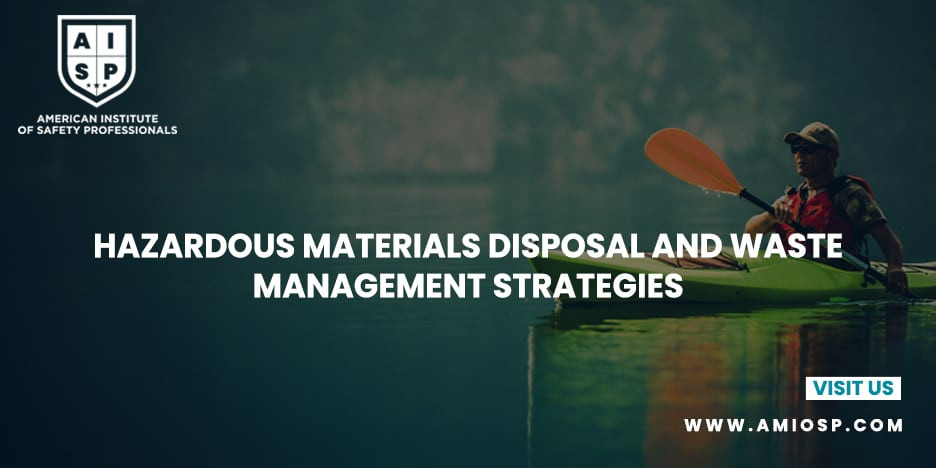Proper disposal and effective waste management are critical
components of handling hazardous materials. The inappropriate handling or
disposal of these substances can pose significant risks to human health and the
environment. In this blog post, we will explore the importance of hazardous
materials disposal, discuss waste management strategies, and highlight best
practices for minimizing the impact of hazardous waste.
1. Introduction: Understanding Hazardous Waste
Hazardous waste refers to any material that poses a
substantial risk to human health or the environment due to its chemical
properties or physical characteristics. Examples of hazardous waste include
chemicals, solvents, heavy metals, radioactive materials, and medical waste.
Proper disposal of these materials is essential to prevent contamination,
pollution, and potential harm to living organisms.
2. Hazardous Waste Classification
Before discussing disposal and waste management strategies,
it is important to understand the classification of hazardous waste. Various
regulatory agencies, such as the Environmental Protection Agency (EPA) in the
United States, have established criteria for identifying and classifying
hazardous waste. Classification helps determine appropriate handling, storage,
and disposal methods based on the level of risk posed by the waste.
3. Waste Minimization and Source Reduction
One of the most effective strategies for managing hazardous
waste is waste minimization and source reduction. This approach focuses on
reducing the quantity of hazardous materials generated at the source. Key
practices include:
- Process
Modification: Modifying production processes to minimize the use of
hazardous materials or substituting them with less hazardous alternatives.
- Inventory
Management: Implementing inventory control systems to prevent
excessive stockpiling of hazardous materials and avoid waste due to
expiration or obsolescence.
- Recycling
and Reuse: Promoting the recycling and reuse of hazardous materials
whenever possible to minimize waste generation.
4. Hazardous Waste Storage and Containment
Proper storage and containment of hazardous waste are
crucial to prevent accidental releases, spills, and leaks. Key considerations
include:
- Segregation
and Compatibility: Segregating different types of hazardous waste to
prevent incompatible materials from coming into contact with each other, could lead to chemical reactions or the release of toxic fumes.
- Containerization
and Labeling: Storing hazardous waste in appropriate containers that
are compatible with the waste and clearly labeling them with relevant
information, such as the type of waste, hazards, and accumulation dates.
- Secondary
Containment: Using secondary containment systems, such as spill trays
or bunds, to prevent the spread of hazardous waste in the event of a spill
or leak.
5. Treatment and Disposal Methods
When hazardous waste cannot be eliminated or recycled, it
must be treated and disposed of using appropriate methods to minimize its
impact. Common treatment and disposal methods include:
- Incineration:
Incineration involves the controlled burning of hazardous waste at high
temperatures to convert it into less harmful byproducts. This method is
suitable for certain types of hazardous waste, such as organic compounds.
- Chemical
Treatment: Chemical treatment processes use specific chemicals or
reactions to neutralize or stabilize hazardous waste, reducing its
toxicity or making it less hazardous.
- Landfill
Disposal: Landfills designed specifically for hazardous waste are
engineered to prevent the migration of contaminants into the environment.
Hazardous waste disposed of in landfills must meet specific regulatory
requirements.
- Biological
Treatment: Biological treatment methods, such as bioremediation or
composting, use microorganisms to break down hazardous waste into less
harmful substances. This method is suitable for certain organic wastes.
6. Regulatory Compliance and Documentation
Compliance with applicable regulations is crucial when
handling, treating, and disposing of hazardous waste. Organizations must adhere
to local, national, and international regulations governing hazardous waste
management. Key aspects of regulatory compliance include:
- Permitting
and Reporting: Obtaining necessary permits for hazardous waste
management activities and submitting regular reports to regulatory
authorities to demonstrate compliance.
- Record
Keeping: Maintaining detailed records of waste generation, storage,
treatment, and disposal activities, including manifests, waste profiles,
and tracking documentation.
- Training
and Certification: Ensuring that personnel involved in hazardous waste
management receive appropriate training and certification to handle the
waste safely and comply with regulations.
7. Collaboration and Continuous Improvement
Managing hazardous waste effectively requires collaboration
among stakeholders, including government agencies, waste management facilities,
and organizations generating hazardous waste. Continuous improvement through
the implementation of best practices, technological advancements, and feedback
loops is essential for minimizing the impact of hazardous waste on the
environment and human health.
8. Conclusion: Protecting the Environment and Human Health
Proper disposal and waste management strategies are
paramount in ensuring the safe handling and elimination of hazardous materials.
By adopting waste minimization practices, implementing effective storage and
containment measures, utilizing appropriate treatment and disposal methods, and
complying with regulatory requirements, we can protect the environment,
safeguard human health, and create a sustainable future for generations to
come. Responsible management of hazardous waste is a shared responsibility that
requires ongoing commitment and collaboration from all stakeholders.












0 comments
No Comments